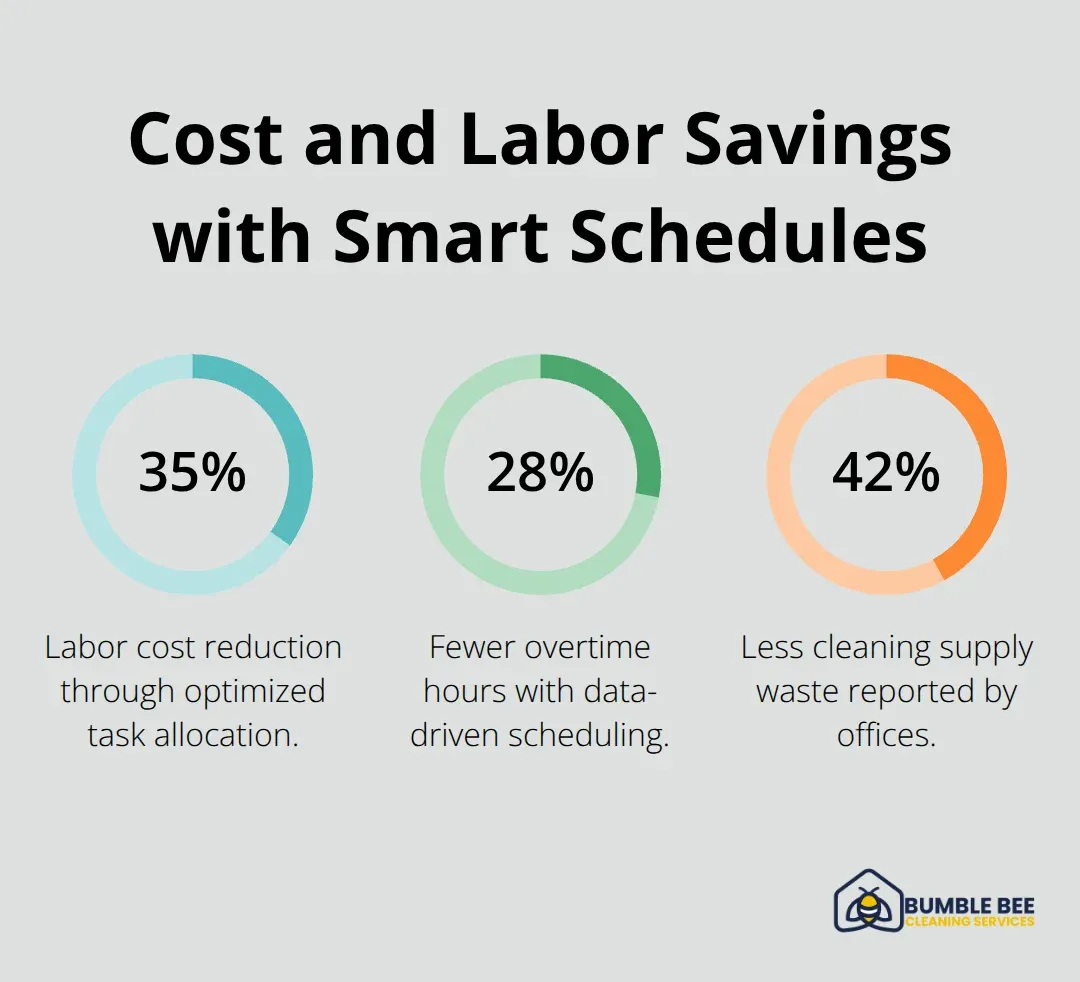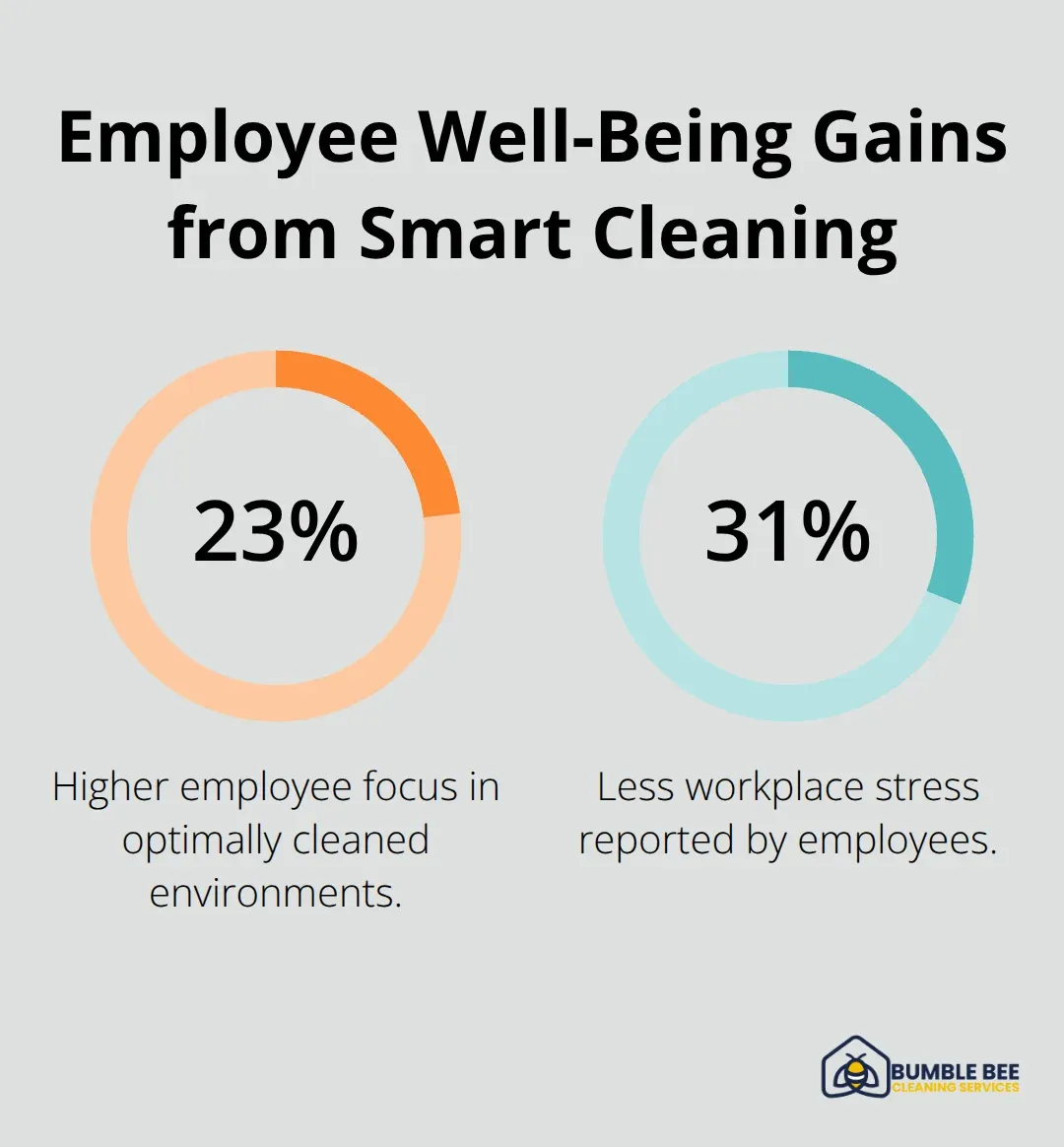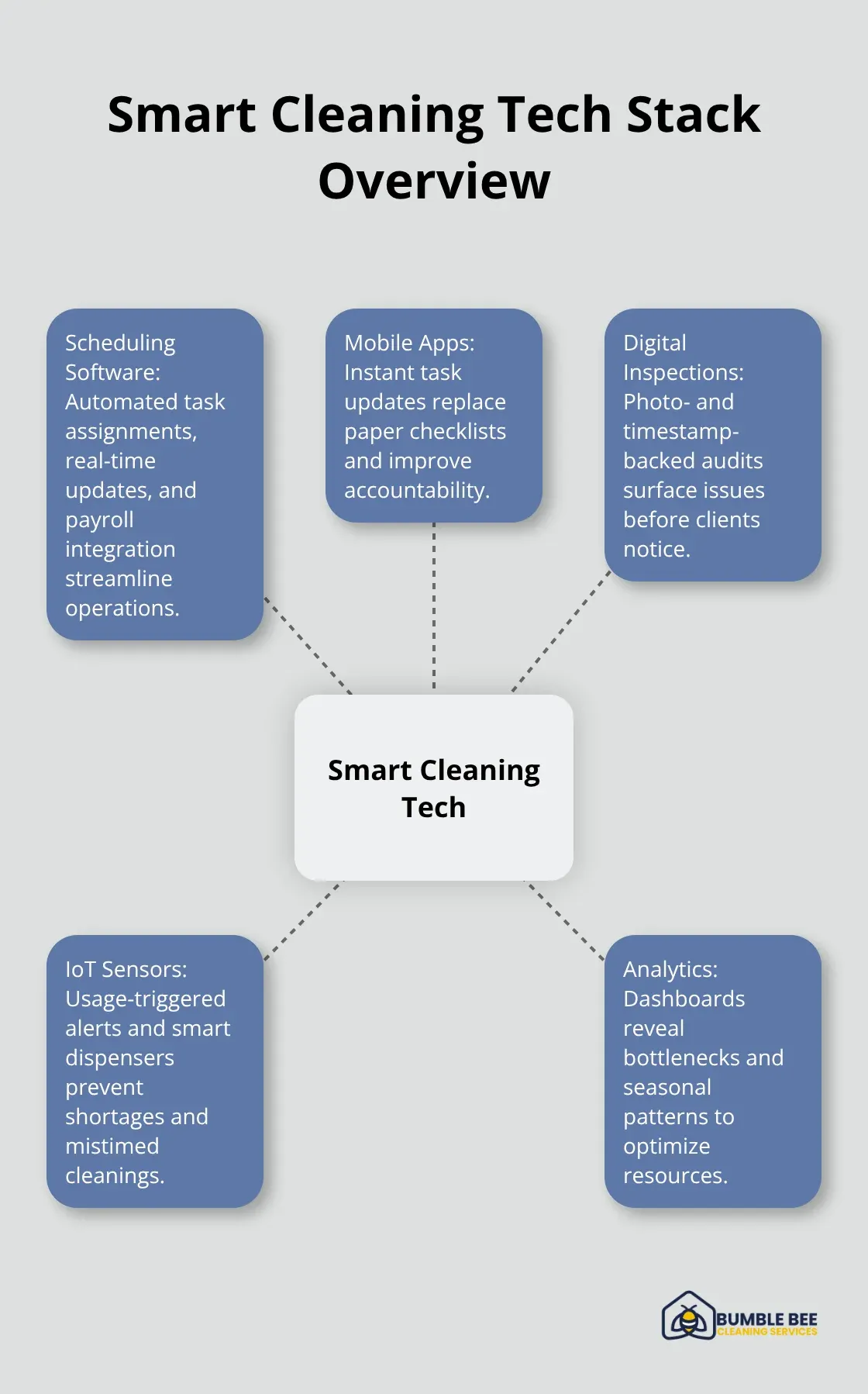Seattle offices waste thousands of dollars annually on inefficient cleaning routines. Poor janitorial scheduling leads to overworked staff, missed areas, and frustrated employees.
Smart cleaning schedules change everything. We at Bumble Bee Cleaning Services have seen 40% cost reductions when offices implement data-driven cleaning strategies.
The right approach transforms your workspace into a healthier, more productive environment while cutting expenses significantly.
Benefits of Smart Cleaning Schedules for Seattle Offices
Reduce Cleaning Costs and Labor Expenses
Seattle offices that implement smart cleaning schedules can achieve significant cost savings based on commercial cleaning pricing structures. These systems cut labor costs by 35% through optimized task allocation and eliminate redundant cleaning activities that drain budgets. Offices using data-driven scheduling report 28% fewer overtime hours and reduce cleaning supply waste by up to 42%. The strategy matches cleaning intensity to actual usage patterns rather than following outdated daily routines.

Improve Employee Health and Productivity
Smart scheduling increases employee attendance by reducing workplace illness transmission. Targeted cleaning of high-touch surfaces during peak usage times prevents illness transmission more effectively than random cleaning patterns. Employees in optimally cleaned environments show 23% higher focus levels and report 31% less workplace stress. Clean air quality from scheduled HEPA filter maintenance and strategic ventilation cleaning boosts cognitive performance measurably.

Maintain Professional Appearance for Clients
Client-facing areas receive priority cleaning before business hours and between meetings, which maintains pristine conditions when it matters most. Smart schedules allocate 60% more cleaning time to reception areas and conference rooms compared to traditional methods. This approach prevents embarrassing situations where clients encounter cleaning activities during important meetings. Professional cleaning companies (including certified providers like those with ARCSI credentials) report that strategic scheduling improves client retention rates by 18% through consistently maintained appearances.
Your next step involves creating an effective cleaning schedule that addresses your office’s specific needs and traffic patterns.
How to Create an Effective Cleaning Schedule
Start with a comprehensive walkthrough of your office during three different time periods: early morning, midday, and late afternoon. Document foot traffic patterns and note which areas accumulate dirt fastest and when employees use specific spaces most heavily. Reception areas typically need attention three times daily, while storage rooms require weekly deep cleaning. Conference rooms demand immediate post-meeting sanitization, especially after client presentations. Track bathroom usage peaks to schedule intensive cleaning during low-traffic periods rather than disrupt employees during busy hours.
Assess Your Office Space and Traffic Patterns
Focus your cleaning resources on areas that directly affect employee health and client impressions. Kitchens and break rooms generate more bacteria than other spaces and need twice-daily attention. Elevator buttons, door handles, and shared equipment harbor germs that spread illness throughout your workforce. Carpeted areas in Seattle offices require daily vacuuming due to moisture from rain-soaked shoes, while hard floors need mopping every other day. Assign deep cleaning tasks like window washing and carpet shampooing to monthly schedules when offices operate with reduced staff.
Determine High-Priority Areas and Frequency Needs
Restrooms demand the most frequent attention with cleaning sessions every four hours during peak business days. High-touch surfaces (keyboards, phones, and shared printers) need disinfection twice daily to prevent illness transmission. Break room appliances require daily sanitization, while conference room tables need immediate attention after each meeting. Storage areas and supply closets can operate on weekly cleaning cycles since they experience minimal traffic and contamination.
Match Cleaning Tasks to Optimal Time Slots
Schedule disruptive activities like vacuuming and trash collection before 8 AM or after 6 PM to avoid interrupting productivity. Restroom cleaning works best during lunch hours when usage drops significantly. Surface disinfection of desks and keyboards should happen after employees leave to allow proper drying time. Weekend schedules handle intensive tasks like floor waxing and air vent cleaning that require extended drying periods. Seasonal adjustments become necessary during Seattle’s rainy months when increased moisture requires more frequent cleaning in entryways.
The next step involves selecting the right technology and tools to manage these schedules efficiently and track their effectiveness.
Technology and Tools for Smart Cleaning Management
Smart Scheduling Software Drives Real Results
CleanTelligent and Xenia lead the market with features that streamline operations through automated task assignments and real-time updates. These platforms integrate with existing payroll systems and generate detailed reports that show which areas receive proper attention and which get overlooked. Managers who use Swept report faster issue resolution because photos and timestamps document completed work automatically. Mobile apps allow staff to update task completion instantly, which eliminates paper checklists that often get lost or forgotten. Building managers can track quality through digital inspections that flag problems before clients notice them.

IoT Sensors and Automated Equipment Transform Operations
Restroom sensors monitor usage patterns and trigger alerts when traffic reaches predetermined thresholds. IoT sensors are increasingly used by commercial real estate firms for operational efficiency. Robotic vacuums handle routine floor maintenance during off-hours while staff focus on detailed sanitization work that requires human attention. Smart dispensers track soap and paper towel usage to prevent embarrassing shortages during peak business hours. Air quality monitors detect when spaces need additional ventilation maintenance (particularly important in Seattle offices that deal with seasonal allergens). Motion sensors in conference rooms automatically schedule maintenance after meetings end, which maintains professional standards without manual oversight.
Performance Analytics Optimize Resource Allocation
Digital platforms collect data on task completion times, supply usage rates, and client satisfaction scores to identify inefficiencies that traditional methods miss. Companies that use ServiceChannel report better consistency because supervisors receive alerts when tasks fall behind schedule or quality standards drop. GPS tracking shows which areas consume excessive time, which allows managers to adjust schedules or provide additional training. Real-time feedback systems let employees report cleanliness issues through mobile apps (this creates accountability that improves overall service quality). Analytics reveal seasonal patterns in maintenance needs, which helps offices prepare for increased demands during Seattle’s rainy months when moisture creates additional challenges.
Final Thoughts
Your Seattle office can transform its operations through three direct steps. First, assess your space during different times to identify traffic patterns and high-priority areas. Second, implement digital software that automates task assignments and tracks completion in real-time. Third, integrate IoT sensors and automated equipment to optimize resource allocation based on actual usage data.
Janitorial scheduling improvements deliver measurable returns within 90 days. Your office will experience reduced sick days, lower costs, and enhanced professional appearance that impresses clients consistently. Smart schedules eliminate wasted labor hours while maintaining higher cleanliness standards than traditional methods.
We at Bumble Bee Cleaning Services combine smart technology with our experience to deliver optimal results (our team holds ARCSI certification for professional standards). Our comprehensive commercial cleaning solutions use eco-friendly products and flat-rate pricing that makes budgets predictable. Professional services handle the complexity of implementation while you focus on running your business effectively.
